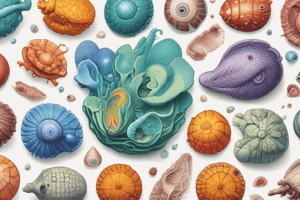Podcast
Questions and Answers
What is a characteristic that all animals share?
What is a characteristic that all animals share?
- Prokaryotic cells
- Presence of cell walls
- Autotrophic nutrition
- Ability to move and capture prey (correct)
What event marks a period of rapid animal diversification?
What event marks a period of rapid animal diversification?
- Origin of life on Earth
- Cambrian explosion (correct)
- Mesozoic era
- Cenozoic era
What type of symmetry do most animals exhibit?
What type of symmetry do most animals exhibit?
- Asymmetry
- Bilateral symmetry (correct)
- Spherical symmetry
- Radial symmetry
What is the term for the succession of cell divisions without growth between divisions in animal embryos?
What is the term for the succession of cell divisions without growth between divisions in animal embryos?
What is the characteristic feature of sponges (Porifera)?
What is the characteristic feature of sponges (Porifera)?
What is the characteristic feature of chordates?
What is the characteristic feature of chordates?
What is the term for the type of development in which the blastopore becomes the anus?
What is the term for the type of development in which the blastopore becomes the anus?
Which group of animals has a lophophore for feeding or a trochophore larval stage?
Which group of animals has a lophophore for feeding or a trochophore larval stage?
What is unique about the formation of the anus in Deuterostomes?
What is unique about the formation of the anus in Deuterostomes?
What is a characteristic of Arthropods?
What is a characteristic of Arthropods?
Which type of tissue is responsible for holding organs and tissues together in place?
Which type of tissue is responsible for holding organs and tissues together in place?
What is the function of fibroblasts in connective tissue?
What is the function of fibroblasts in connective tissue?
What is a characteristic of Chordate embryos?
What is a characteristic of Chordate embryos?
What is the primary function of the swim bladder in fish?
What is the primary function of the swim bladder in fish?
Which group of animals are characterized by their ability to metabolize at a high rate?
Which group of animals are characterized by their ability to metabolize at a high rate?
What is the function of the amniotic egg in reptiles and mammals?
What is the function of the amniotic egg in reptiles and mammals?
Flashcards are hidden until you start studying
Study Notes
Common Characteristics of Animals
- Animals can move and capture prey, and are multicellular, eukaryotes, and heterotrophic, with no cell walls.
- They are thought to have evolved from flagellated protists, with choanoflagellates being the closest living relatives.
Animal Body Plan
- Radial symmetry vs. bilateral symmetry: most animals have bilateral symmetry, allowing for faster movement and formation of a head with sensory organs and a central nervous system.
Embryo Development
- Animal zygotes undergo cleavage, a series of cell divisions without growth between divisions, forming a blastula.
- The blastula is often a hollow ball of cells.
Animal Tissues
- Only a few groups, such as sponges, have no tissue.
- Most animals have germ layers that give rise to tissues and organs, including:
- Diploblastic: ectoderm and endoderm.
- Triploblastic: ectoderm, endoderm, and mesoderm.
- Body cavity types:
- Coelom: a cavity surrounded by tissues derived from mesoderm.
- Hemocoel: filled with hemolymph.
- Some animals have no cavity at all, such as flatworms.
Protostome vs. Deuterostome Development
- In protostome development, the blastopore becomes the mouth.
- In deuterostome development, the blastopore becomes the anus.
Invertebrate Animals
- Invertebrates are animals without a backbone.
- Examples of invertebrate phyla include:
- Porifera (sponges): simplest animals, filter feeders, no tissue.
- Cnidarians: true tissues, gastrovascular cavity, polyps and medusa life forms, nematocysts, radial symmetry.
- Lophotrochozoans: have a lophophore for feeding or a trochophore larval stage.
- Flatworms (platyhelminthes): flat body form for large surface area.
- Molluscs: muscular foot, visceral mass, mantle.
- Annelids: segmented worms, coelom.
- Ecdysozoans: cuticle, molting.
- Nematodes: have hemocoel.
- Arthropods: segmented body, exoskeleton, jointed appendages, open circulatory system.
Vertebrate Animals
- Common characteristics of chordates: bilateral, deuterostome development, mostly vertebrates with two groups of invertebrates.
- Four characteristics of chordate embryos:
- Notochord.
- Dorsal nerve cord.
- Pharyngeal pouches (slits).
- Post-anal tail.
- Examples of vertebrate groups:
- Hagfishes and lampreys: lacking jaws.
- Shark and ray: oil in the liver to maintain buoyancy.
- Ray-finned and lobe-fin fish: swim bladder for buoyancy.
- Amphibians: need water and land, metamorphosis.
- Reptiles: scales, shelled and amniotic eggs, ectothermic.
- Birds: endothermic, direct descendants of dinosaurs.
- Mammals: mammary glands, hair, endothermy.
Animal Form and Function
- Tissues: groups of cells with a similar appearance and function.
- Four types of tissues:
- Epithelial tissue: covers the outside of the body and lines organs and cavities.
- Connective tissue: holds tissues and organs together in place.
- Muscle tissue: responsible for movement and contractions.
- Nervous tissue: responsible for communication and coordination.
- Functions of specific tissues:
- Fibroblasts: secrete fiber proteins.
- Macrophages: engulf foreign particles.
Studying That Suits You
Use AI to generate personalized quizzes and flashcards to suit your learning preferences.




